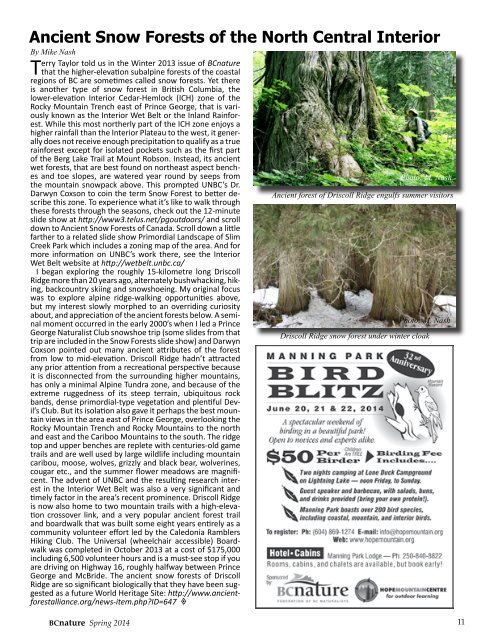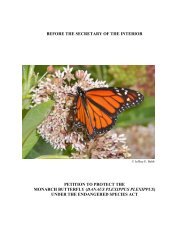BC-Nature-Spring-2014-web-final
BC-Nature-Spring-2014-web-final
BC-Nature-Spring-2014-web-final
You also want an ePaper? Increase the reach of your titles
YUMPU automatically turns print PDFs into web optimized ePapers that Google loves.
Ancient Snow Forests of the North Central Interior<br />
By Mike Nash<br />
Terry Taylor told us in the Winter 2013 issue of <strong>BC</strong>nature<br />
that the higher-elevation subalpine forests of the coastal<br />
regions of <strong>BC</strong> are sometimes called snow forests. Yet there<br />
is another type of snow forest in British Columbia, the<br />
lower-elevation Interior Cedar-Hemlock (ICH) zone of the<br />
Rocky Mountain Trench east of Prince George, that is variously<br />
known as the Interior Wet Belt or the Inland Rainforest.<br />
While this most northerly part of the ICH zone enjoys a<br />
higher rainfall than the Interior Plateau to the west, it generally<br />
does not receive enough precipitation to qualify as a true<br />
rainforest except for isolated pockets such as the first part<br />
of the Berg Lake Trail at Mount Robson. Instead, its ancient<br />
wet forests, that are best found on northeast aspect benches<br />
and toe slopes, are watered year round by seeps from<br />
the mountain snowpack above. This prompted UN<strong>BC</strong>’s Dr.<br />
Darwyn Coxson to coin the term Snow Forest to better describe<br />
this zone. To experience what it’s like to walk through<br />
these forests through the seasons, check out the 12-minute<br />
slide show at http://www3.telus.net/pgoutdoors/ and scroll<br />
down to Ancient Snow Forests of Canada. Scroll down a little<br />
farther to a related slide show Primordial Landscape of Slim<br />
Creek Park which includes a zoning map of the area. And for<br />
more information on UN<strong>BC</strong>’s work there, see the Interior<br />
Wet Belt <strong>web</strong>site at http://wetbelt.unbc.ca/<br />
I began exploring the roughly 15-kilometre long Driscoll<br />
Ridge more than 20 years ago, alternately bushwhacking, hiking,<br />
backcountry skiing and snowshoeing. My original focus<br />
was to explore alpine ridge-walking opportunities above,<br />
but my interest slowly morphed to an overriding curiosity<br />
about, and appreciation of the ancient forests below. A seminal<br />
moment occurred in the early 2000’s when I led a Prince<br />
George Naturalist Club snowshoe trip (some slides from that<br />
trip are included in the Snow Forests slide show) and Darwyn<br />
Coxson pointed out many ancient attributes of the forest<br />
from low to mid-elevation. Driscoll Ridge hadn’t attracted<br />
any prior attention from a recreational perspective because<br />
it is disconnected from the surrounding higher mountains,<br />
has only a minimal Alpine Tundra zone, and because of the<br />
extreme ruggedness of its steep terrain, ubiquitous rock<br />
bands, dense primordial-type vegetation and plentiful Devil’s<br />
Club. But its isolation also gave it perhaps the best mountain<br />
views in the area east of Prince George, overlooking the<br />
Rocky Mountain Trench and Rocky Mountains to the north<br />
and east and the Cariboo Mountains to the south. The ridge<br />
top and upper benches are replete with centuries-old game<br />
trails and are well used by large wildlife including mountain<br />
caribou, moose, wolves, grizzly and black bear, wolverines,<br />
cougar etc., and the summer flower meadows are magnificent.<br />
The advent of UN<strong>BC</strong> and the resulting research interest<br />
in the Interior Wet Belt was also a very significant and<br />
timely factor in the area’s recent prominence. Driscoll Ridge<br />
is now also home to two mountain trails with a high-elevation<br />
crossover link, and a very popular ancient forest trail<br />
and boardwalk that was built some eight years entirely as a<br />
community volunteer effort led by the Caledonia Ramblers<br />
Hiking Club. The Universal (wheelchair accessible) Boardwalk<br />
was completed in October 2013 at a cost of $175,000<br />
including 6,500 volunteer hours and is a must-see stop if you<br />
are driving on Highway 16, roughly halfway between Prince<br />
George and McBride. The ancient snow forests of Driscoll<br />
Ridge are so significant biologically that they have been suggested<br />
as a future World Heritage Site: http://www.ancientforestalliance.org/news-item.php?ID=647<br />
<br />
Photo: M. Nash<br />
Ancient forest of Driscoll Ridge engulfs summer visitors<br />
Photo: M. Nash<br />
Driscoll Ridge snow forest under winter cloak<br />
<strong>BC</strong>nature <strong>Spring</strong> <strong>2014</strong> 11




